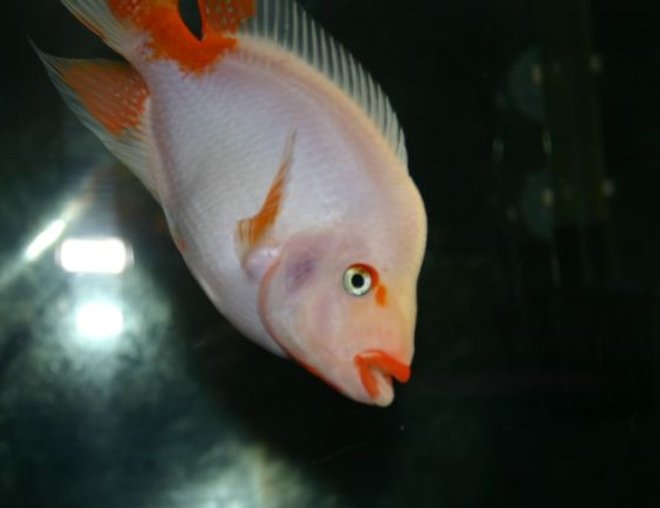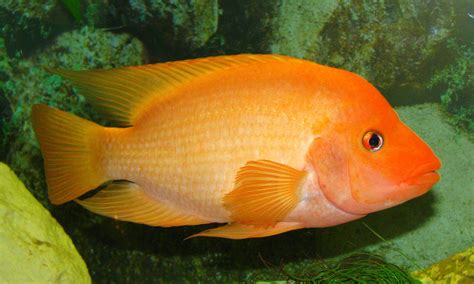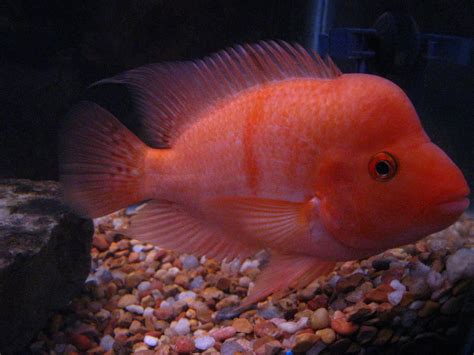
In the world of aquatic pets, few are as distinct, charismatic and vivid as the red devil fish. This fascinating species, with its striking appearance and intriguing behaviors, captivates aquarists across the globe. This guide offers an in-depth exploration of the world of red devil fish, providing valuable insights for both novice aquarists and seasoned hobbyists.
The red devil fish, scientifically known as Amphilophus labiatus, is a species of large cichlid native to Central America. It’s famed for its aggressive temperament that led to its ominous name, and yet, its vibrantly colored scales and outgoing nature have earned it a spot in many aquariums around the world.
However, ensuring a healthy and happy environment for these fish requires a unique set of care strategies. The care of the red devil fish extends beyond just feeding and tank cleaning. It involves considering factors like tank size, water temperature and pH, feeding habits, tank mates, and breeding.
In this guide, we will delve comprehensively into what it takes to take care of this beautiful but demanding aquatic creature, demystifying everything you need to know about breeding and tank requirements.
Understanding Red Devil Fish Behavior
Red Devil Fish exhibit a range of behaviors that are crucial for their survival and prosperity in their aquarist tanks. Known for their territorial nature, aggressiveness, and dynamic personalities, understanding their behavior is an essential step in providing them with adequate care.
Aggressive and Territorial Nature
One of the most distinguishing characteristics of the Red Devil Fish is its aggressiveness. They tend to be extremely territorial, especially during the breeding season, often fighting with other fish for territory if kept in the same tank. This aggressive behavior extends to their owners as well since they can also exhibit biting actions towards human hands when performing tank maintenance.
Social and Interactive
Despite their aggressive nature, Red Devil Fish are known to be great observers with a high level of intelligence. They are particularly curious about their surroundings as well as their owners, and they recognize their owners very quickly through daily interactions.
The list below summarizes some common behaviors that a Red Devil Fish exhibits:
- They are eager eaters often gulping down their food and are always ready for feeding time.
- Interaction with their owners and showing excitement when their owners are near the tank.
- A digging behavior is visible where they move sand or pebbles in the tank, redecorating as per their preference.
Understanding these behaviors of Red Devil Fish will help in their effective care and breeding. It is always suggested to study their behavior keenly before adopting one to ensure harmony in the tank environment.
Caring for a Red Devil Fish: Essentials
The Red Devil Fish, known scientifically as Amphilophus labiatus, is a vibrant and spirited specimen that requires attentive care. It’s not a fish for beginners, but if you’re passionate about aquariums and ready for a challenge, it can make for a compelling and rewarding pet. Let’s delve into the essentials of caring for a Red Devil Fish.
Diet
Red Devil Fish are omnivores. They enjoy a varied diet of both plants and animal matter. High-quality pellets can form the basis of their diet. Supplement these with fresh, frozen, or freeze-dried foods like shrimp, peas, or spinach. It’s vital to feed them a balanced diet to maintain their health and stunning coloration.
Water Conditions
These fish thrive in warm water, so keep your aquarium between 72-82 °F. They prefer a neutral to slightly alkaline pH level, between 6.5 and 8.0. Regular water changes are also necessary to ensure optimal health and reduce levels of waste and toxins.
Tank Setup
Red Devil Fish need plenty of space to swim and grow. A tank of at least 55 gallons is recommended for one fish. It’s also important to include hiding spots in your tank using rocks or driftwood. However, be aware that they are known to rearrange their surroundings, so be sure to secure any decorations.
Social Behavior
Red Devil Fish are known for their aggressive behavior. They should be kept alone or with other fish that can handle themselves. Be prepared for territorial disputes and try to provide enough space and hiding spots to manage aggression.
With the right care, Red Devil Fish can make a remarkable addition to your aquarium. Remember, they’re a commitment and are most suited to experienced aquarists.
Dietary Needs of Red Devil Fish

The Red Devil Fish is an omnivorous species that can feed on a wide variety of foods. However, providing a balanced diet is essential for its overall health and wellbeing.
Red Devil Fish primarily feed on small fish and insects in the wild. They are also known to consume certain types of water plants. Therefore, a diet mimicking these conditions should be provided in a home aquarium. Live foods, like brine shrimp and bloodworms, can be offered on a regular basis. But, do remember that they should be fed live foods sparingly as it may cause a digestive problem if overfed.
Additionally, they can also feed on high-quality processed foods available in the market. These include pellets, flakes, frozen, and freeze-dried foods. Regular feeding of these foods can ensure they receive all the necessary nutrients they need for a healthy life.
It is important to note that Red Devil Fish have a robust appetite, however, overfeeding should strongly be avoided. Overfeeding can result in obesity and other health-related issues like bloating and swim bladder disease. Hence, an optimum feeding schedule would be small meals two to three times a day.
Lastly, always ensure the food is appropriately sized. Food that is too large may pose a choking risk while food that’s too small might not satisfy their hunger.
In conclusion, a carefully planned and balanced diet will go a long way in ensuring your Red Devil Fish thrives in its home aquarium setting.
Red Devil Fish Aquarium Setup: What’s Required?
The Red Devil Fish, known scientifically as Amphilophus labiatus, is a vibrant, energetic, and aggressive species, which makes precise aquarium setup crucial for its survival and well-being. The major requirements include the tank size, water parameters, and suitable decorations.
| Requirements | Details |
|---|---|
| Tank Size | A minimum tank size of 55 gallons for a single Red Devil Fish. Larger sizes are preferred since they are energetic swimmers. A larger tank can also help to minimize their territorial aggressiveness. |
| Water Parameters | Temperature should be kept between 75 – 79°F (24 – 26°C), the pH level should be between 6.5 – 7.5, and hardness should be 6 – 25 dGH. |
| Decorations | Opt for sturdy plants and rock formations where this fish can hide. Do remember that they are diggers and may uproot plants or move smaller rocks. |
In addition to these, it’s important to include a suitable filtration system as the Red Devil Fish produces a considerable amount of waste. Regular water changes, approximately 10-20% per week, can help maintain optimal water conditions.
Although the Red Devil Fish can be challenging for novice aquarists due to their aggressive behavior and specific care requirements, providing them with an appropriate environment will ensure their health and longevity.
Maintaining Optimal Water Conditions for Red Devils
As a fish enthusiast, maintaining optimal water conditions is crucial to keep your Red Devil healthy and happy. Unlike most other fish, Red Devils are highly sensitive to changes in their environment, specifically the quality of the water they live in. By being diligent about maintaining water quality, you can save these vibrant fishes from getting stressed or falling ill due to inadequate conditions.
Water Temperature
The Red Devil hails from the warm waters of Central America, which means they thrive best in warmer temperatures. The most suitable temperature lies between 75°F and 79°F. Keeping a stable temperature within this range is crucial as sudden swings could be fatal for Red Devils.
pH Levels
The water’s pH level is another significant parameter for Red Devils. These fish thrive in slightly alkaline water with a pH range from 6.5 to 7.5. Anything below or above this range can profoundly affect their health. Therefore, it’s essential to consistently monitor and maintain the water’s pH level, making necessary adjustments when required.
From the above, it can be seen that providing optimal conditions for the Red Devil fish might seem challenging at first. However, with a regulated heater and frequent water pH tests, it is entirely possible to create a delightful and advantageous environment your Red Devil Fish will thrive in.
Breeding Process of Red Devil Fish

The breeding process of the Red Devil Fish, formally known as Amphilophus labiatus, is a fascinating and complex procedure. These fish have strict requirements and unique habits when it comes to reproduction.
Courtship and Mating
The breeding process begins with a courtship period. Red Devil Fish perform a variety of dances and displays in order to attract a mate. This includes diverse patterns of movement and shape changing. Once a pair has formed, the male will guard the female, showing signs of aggression towards other males.
After courtship comes the mating stage. The female will lay hundreds of eggs in a flat surface within the tank, usually on a rock, and the male will then fertilize these eggs. It is important to note that Red Devil Fish are incredibly protective parents and will become more aggressive when they are guarding their eggs.
Incubation and Hatching
The eggs take about three to four days to hatch, during which time the parents take turns to guard and circulate water around them. Post hatching, the larvae stay in a pit dug by the parents, who continue their guard duty. The marine babies grow fairly quickly and start swimming in about seven days.
- Temperature: Red Devil Fish thrive in warm water. A temperature of around 77-86°F is considered optimal for the hatching process.
- Feeding: As the fish grow, it’s important to feed them properly. A diet rich in protein is necessary for the newly-hatched Red Devil Fish, with brine shrimp being the commonly preferred choice.
- Space: As the babies grow, they will need more space. Many breeders separate them into different tanks to avoid aggression and to create more suitable living conditions.
All these processes make the breeding of Red Devil Fish an interesting, yet challenging task. Understanding and anticipating their needs is crucial to successfully breed these fish in aquarium conditions. Be prepared to make adjustments and provide care as necessary to ensure the health and growth of these gorgeous fish.
Common Challenges in Red Devil Fish Care
The care for Red Devil Fish comes with unique challenges that potential owners must be aware of. The distinctive personality and specific care requirements of this fish species can sometimes be difficult to manage.
Aggressive Nature
Red Devil Fish, famous for their vibrant color and large size, are notoriously aggressive. This temperamental behavior usually results in the species being unsuitable for a community tank. They are better suited for a single-species tank. With this issue in mind, aquarists need to plan in advance the suitable environment for their Red Devils.
Dietary Requirements
Another difficulty to overcome while taking care of a Red Devil Fish is their dietary requirements. These fish are omnivores and require a diverse diet that includes both meat and vegetables. Providing a balanced and nutritious diet is crucial for the fish’s health and well-being. Lack of proper nutrition can lead to various health issues.
- Health Problems: Red Devil Fish can be prone to several health issues, such as skin flukes, parasitic infestations, bacterial infections, and Hole-in-Head Disease. Accurate diagnosis and suitable treatments are necessary to tackle these health challenges.
- Tank Size: These are large fishes that require plenty of space to swim freely. A cramped tank can lead to stress and health issues for the Red Devil Fish.
- Water Conditions: Red Devil Fish are sensitive to changes in water parameters like pH and temperature. Maintaining consistent water conditions in the tank can be a challenging task.
In conclusion, while Red Devil Fish are colorful and appealing to pet owners, they require diligent care and attention. Overcoming these challenges can be quite rewarding, as these fish are known for their playful antics and engaging personalities.
Question-answer,
What exactly is a Red Devil Fish?
The Red Devil Fish, also known as Amphilophus labiatus, is a species of cichlid native to Nicaragua and Costa Rica. They are popular in the aquarium trade due to their bright colors, which range from gray to a striking red. They are also known for their aggressive behavior, thus the name “Red Devil”. They have thick lips and powerful jaws that can crush shells, which they use in their natural habitat to feed on smaller fishes, insects, snails, and other crustaceans.
What are the tank requirements for a Red Devil Fish?
Red Devil Fish need a large tank, as they can grow up to 15 inches long. A minimum of 55 gallons is recommended, but a larger tank would be better. The tank should have a sand or gravel substrate, and some hiding spots like rocks or driftwood. However, be aware that Red Devils are known to rearrange their tanks, so don’t be surprised if things get moved around. The water temperature should be kept between 75-79F, with a pH range of 6.5-7.5.
How should I care for a Red Devil Fish?
Caring for a Red Devil Fish involves providing a balanced diet, keeping a clean habitat, and observing any changes in their behavior or appearance. They are omnivorous, and their diet in the tank can include pellets, flakes, frozen or live foods. They are aggressive fish and need to be kept either alone or with other fish that can handle their temperament. Regular water changes are necessary to keep their environment clean.
Can you tell me more about Red Devil Fish breeding?
Red Devil Fish are fascinating breeders. They are monogamous and form pairs. The female lays hundreds of eggs on a flat surface, such as a rock or the side of the aquarium, and the male fertilizes them. Both parents guard the eggs and tend to their fry once they hatch. Breeding Red Devils in captivity can be difficult due to their aggression levels, but it is not impossible.
Are Red Devil Fish suitable for beginners?
Due to their aggressive nature and specific requirements for care and habitat, Red Devil Fish may not be the best choice for beginner aquarists. They are better suited to those with some experience in fish-keeping who understand their needs and can provide a suitable environment for them to thrive. They also need a lot of space and a carefully thought-out diet, so they are more of a commitment than some other types of fish.